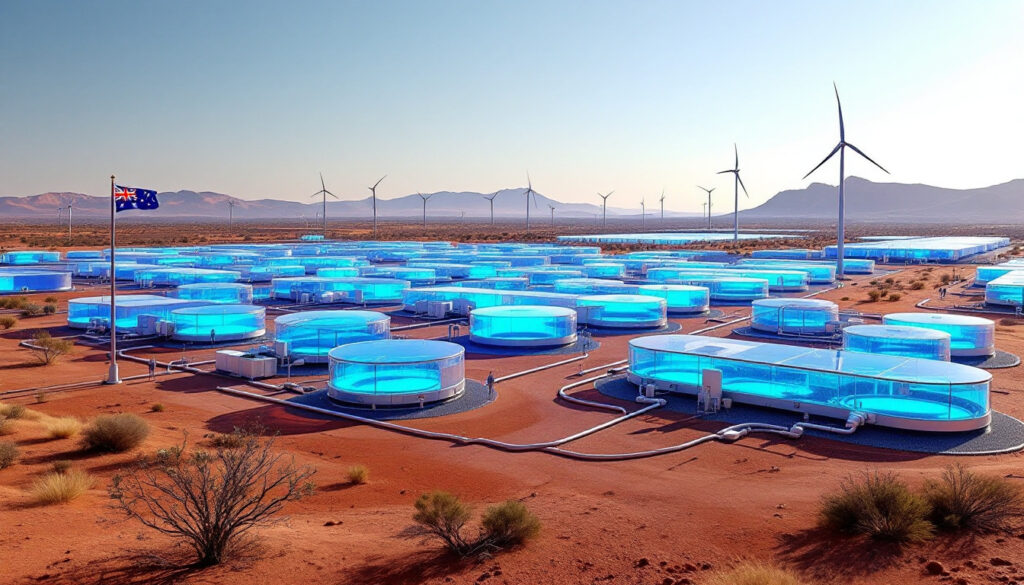What is the Vanadium Battery Project in Kalgoorlie?
The Kalgoorlie vanadium flow battery project represents a significant advancement in Western Australia's renewable energy infrastructure. This innovative energy storage solution aims to address persistent power reliability issues while positioning the Goldfields region at the forefront of sustainable clean energy revolution.
The $150 Million Election Commitment
Western Australia's Labor government has pledged $150 million toward constructing Australia's largest vanadium flow battery in Kalgoorlie-Boulder. With a planned capacity of 50 megawatts, this ambitious project aims to revolutionize energy storage in the region. Premier Roger Cook announced that the battery would utilize locally sourced and processed vanadium, with operations expected to commence by 2029.
The project's timing aligns strategically with Western Australia's broader energy transition, coinciding with the scheduled decommissioning of the state's final coal-fired power station in Collie.
Strategic Importance for the Region
Kalgoorlie-Boulder stands at a critical juncture on Western Australia's power grid, positioned at the edge of the South West Interconnected System (SWIS). This location has historically experienced frequent power disruptions, affecting both residential consumers and the region's vital mining operations.
The vanadium battery installation addresses several key strategic objectives:
- Strengthening grid resilience in a region prone to outages
- Supporting the transition from coal-fired power generation
- Enabling expansion of mining operations currently constrained by power limitations
- Creating a showcase for advanced energy technology in regional Australia
For Kalgoorlie-Boulder, a city economically driven by mining activities, reliable power infrastructure is not merely a convenience but an essential component for industrial growth and sustainability.
Why is Vanadium Flow Battery Technology Being Chosen?
Advantages of Vanadium Flow Batteries
Vanadium flow battery technology offers several compelling advantages over conventional lithium-ion batteries, particularly for grid-scale applications in harsh environments like Kalgoorlie:
- Non-flammable chemistry: The water-based electrolyte eliminates fire risks associated with lithium-ion technology
- Exceptional longevity: 20-30 year operational life without significant capacity degradation
- Complete recyclability: The vanadium electrolyte retains its value and can be fully recycled at end-of-life
- Temperature resilience: Performs effectively in extreme heat without requiring expensive cooling systems
- Scalable capacity: The energy storage capacity can be increased simply by expanding electrolyte tanks
- Deep discharge capability: Can be fully discharged without damage to the system
- Long-duration storage: Ideal for applications requiring extended power discharge periods
These characteristics make vanadium flow batteries particularly well-suited for the Kalgoorlie environment, where temperatures regularly exceed 40°C during summer months and where mining industry transformation requires consistent, reliable power supply.
Current Testing in Kununurra
Western Australia is already gaining practical experience with vanadium flow technology. In November 2023, a smaller 78-kilowatt vanadium flow battery was commissioned in Kununurra in the state's remote Kimberley region.
This pilot installation has served as a valuable testing ground, particularly for assessing thermal resilience. According to Horizon Power's future technology and innovation manager David Edwards, the Kununurra battery has demonstrated exceptional performance:
"The battery has exceeded our performance expectations in extreme temperatures, even without requiring a dedicated cooling system. This is a critical advantage in remote locations where maintenance and cooling infrastructure would add significant complexity and cost."
The success of this smaller installation provides important validation for the larger Kalgoorlie project, demonstrating the technology's viability in Western Australia's challenging climate conditions.
What Challenges Face the Kalgoorlie Battery Project?
Vanadium Supply Constraints
Perhaps the most significant challenge for the Kalgoorlie vanadium battery in Kalgoorlie project involves establishing a reliable vanadium supply chain. Western Australia currently lacks active vanadium production, creating a critical gap in the plan to use "locally sourced and processed vanadium."
The state's only vanadium mine at Windimurra near Mount Magnet has been inactive since 2014, when a devastating fire damaged its processing plant. Although the region possesses significant vanadium deposits, bringing a new mine online involves substantial investments and regulatory hurdles:
- Environmental impact assessments and approvals
- Construction of specialized processing facilities
- Development of transportation infrastructure
- Establishment of refining capability for battery-grade vanadium
Without these elements in place, the project may need to initially rely on imported vanadium, potentially from major producers like China, Russia, or South Africa—contradicting the goal of local content.
Timeline Feasibility
The opposition has voiced significant skepticism regarding the project's ambitious timeline. Opposition energy spokesperson Steve Thomas characterized the plan as "entirely aspirational" and "highly optimistic," pointing to several factors that could delay implementation:
- Grid connection approvals typically require a two-year process
- Environmental assessments for new mining operations can span multiple years
- Construction of specialized battery facilities requires specialized expertise
- Global supply chain constraints for key components may create bottlenecks
Energy infrastructure projects of this scale rarely proceed without delays, raising questions about whether the 2029 operational target represents a realistic timeframe or an overly optimistic political promise.
Grid Integration Complexities
Integrating a 50-megawatt flow battery into the existing power infrastructure presents significant technical challenges. The battery must be properly synchronized with the SWIS, which currently extends over 600 kilometers from the Muja power station in Collie to Kalgoorlie-Boulder.
This aging transmission network has historically been vulnerable to extended outages, particularly during extreme weather events. The battery installation will require:
- Substantial grid connection infrastructure
- Advanced control systems for monitoring and dispatch
- Protective equipment to prevent cascade failures
- Specialized expertise for commissioning and operation
While these challenges are surmountable, they add complexity to the project timeline and implementation strategy.
How Does This Compare to Other Battery Projects?
Synergy's Lithium-Ion Precedent
Western Australia has already taken steps toward grid-scale battery storage. The state-owned utility Synergy commissioned its first large battery installation in September 2023 at Kwinana, near Perth. This lithium-ion facility established important precedents for battery integration into the WA grid.
While the Kwinana project provides valuable experience with grid-scale storage, the Kalgoorlie battery employs fundamentally different technology with distinct characteristics and applications. The two projects complement each other, providing diversification in the state's energy storage portfolio and supporting the growing lithium battery market.
Comparison Table: Vanadium Flow vs. Lithium-Ion Batteries
| Feature | Vanadium Flow Battery | Lithium-Ion Battery |
|---|---|---|
| Lifespan | 20-30 years | 8-15 years |
| Fire risk | Non-flammable | Potential thermal runaway |
| Recyclability | Fully recyclable electrolyte | Partially recyclable components |
| Energy density | Lower (requires more space) | Higher (more compact) |
| Temperature tolerance | Excellent without cooling | Requires active cooling systems |
| Initial cost | Higher upfront investment | Lower initial cost |
| Depth of discharge | Can be fully discharged | Limited depth of discharge |
| Scalability | Energy capacity easily expanded | Modular expansion required |
| Self-discharge rate | Minimal | Higher self-discharge |
| Cycle degradation | Minimal capacity loss over time | Gradual capacity reduction |
This comparison highlights why vanadium flow technology may be preferable for Kalgoorlie's specific requirements, particularly regarding temperature resilience, longevity, and deep discharge capability—all critical factors for grid stability in remote mining regions.
What Would the Battery Mean for Kalgoorlie's Power Needs?
Addressing Critical Infrastructure Gaps
Kalgoorlie-Boulder's mining industry has long been hampered by power constraints that limit operational capacity and expansion. Mayor Glenn Wilson has been vocal about how additional power capacity could transform the region's economic landscape:
"Reliable power infrastructure is the foundation for mining expansion in the Goldfields. With additional generation and storage capacity, mines could increase production, generating more royalties for Western Australia and creating hundreds of additional jobs throughout our region."
The 50-megawatt capacity would provide a significant buffer against outages while potentially enabling expansion of energy-intensive operations like mineral processing, which has traditionally been constrained by power limitations.
Recent Power Reliability Issues
The region's power reliability problems were dramatically highlighted during the November 2023 opening of an $800 million rare earths refinery in West Kalgoorlie. During a media tour attended by Federal Resources Minister Madeleine King, the facility experienced an embarrassing power outage—precisely the type of disruption that undermines industry confidence in regional infrastructure.
Such incidents have financial implications far beyond temporary inconvenience:
- Production losses during downtime
- Potential damage to sensitive equipment
- Safety concerns during unexpected shutdowns
- Reduced investor confidence in regional operations
For mining operations with high fixed costs, power reliability directly impacts profitability and operational viability, significantly affecting mining sector trends.
Economic Development Potential
Beyond addressing immediate power reliability issues, the vanadium battery project could serve as a catalyst for broader economic development in the Goldfields region:
- Mining expansion: Enabling growth of operations currently constrained by power limitations
- Value-added processing: Supporting advanced mineral processing that requires stable power
- Technical expertise: Creating high-skilled jobs in battery maintenance and operation
- Technology showcase: Positioning Kalgoorlie as a center for advanced energy technology
- Supply chain development: Potentially stimulating local vanadium mining and processing
The project aligns with Western Australia's strategy to move up the value chain in battery minerals, transitioning from simply exporting raw materials to developing advanced technology applications within the state.
Is Local Vanadium Production Possible by 2029?
Australian Vanadium's Development Timeline
ASX-listed Australian Vanadium is currently making progress on regulatory approvals for a vanadium mine near Meekatharra in WA's Midwest region. The company already operates a vanadium electrolyte manufacturing plant in Perth, demonstrating capability in the critical processing stage.
According to Australian Vanadium CEO Graham Arvidson, the overall timeline for the Kalgoorlie battery is "achievable," though he has expressed reservations about the project's local content aspirations:
"The 2029 timeline is feasible for battery installation, but developing a complete domestic supply chain from mining through processing to battery-grade vanadium electrolyte within that timeframe will be extremely challenging. We may need to consider a phased approach, potentially beginning with imported vanadium while local production capabilities are established."
Current Supply Chain Realities
Australian Vanadium provided the electrolyte for the Kununurra battery trial using imported vanadium, highlighting the current dependency on international sources. Developing a complete domestic supply chain involves multiple complex stages:
- Mining of vanadium-bearing ore
- Concentration and initial processing
- Conversion to vanadium pentoxide
- Dissolution into battery-grade electrolyte
- Quality control and certification
- Transportation and handling infrastructure
Each stage requires specialized equipment, expertise, and regulatory approvals—all potential bottlenecks in an ambitious development timeline.
Potential Production Scenarios
For the Kalgoorlie battery to use locally sourced vanadium by 2029, several pathways exist, each with distinct challenges:
-
Reopening Windimurra: Rehabilitating the dormant mine would provide the fastest route to production but requires significant capital investment to replace damaged processing facilities.
-
Developing new deposits: Companies like Australian Vanadium are advancing new projects, but these typically require 5-7 years from approval to production.
-
Hybrid approach: Beginning with imported vanadium while accelerating local production could balance timeline constraints with local content objectives.
-
Government incentives: Targeted support and streamlined approvals could potentially accelerate development timelines for critical projects.
The feasibility of these scenarios depends largely on market conditions, regulatory efficiency, and the government's willingness to provide support for accelerated development.
What Makes Vanadium Flow Batteries Suitable for Kalgoorlie?
Climate Compatibility
Kalgoorlie-Boulder experiences extreme temperature variations, with summer maximums regularly exceeding 40°C and winter minimums occasionally dropping below freezing. These conditions pose significant challenges for conventional battery technologies but align well with vanadium flow batteries' operational characteristics.
The absence of cooling requirements provides several advantages:
- Reduced operational costs in a region with high electricity prices
- Simpler maintenance requirements in a location with limited technical support
- Greater reliability during heatwaves when power demand peaks
- Lower water consumption in an arid environment
These climate compatibility factors make vanadium flow technology particularly well-suited to Kalgoorlie's harsh environmental conditions.
Duration Requirements
The region's power needs often involve extended outages due to the vulnerability of long transmission lines stretching from Collie. Unlike lithium-ion batteries, which typically provide 1-4 hours of discharge at full capacity, vanadium flow batteries can be economically designed for much longer durations:
- 6-12 hour discharge capabilities are common
- Energy capacity can be increased by simply adding more electrolyte
- Full depth of discharge doesn't damage the system
- Multiple consecutive days of operation are possible with proper sizing
This long-duration capability makes vanadium flow technology ideal for providing reliable backup during extended grid disruptions—a critical advantage for mining operations that face significant costs from unplanned shutdowns.
Mining Industry Alignment
As a mining-focused community, Kalgoorlie-Boulder possesses infrastructure and expertise that aligns well with vanadium mining and processing. The region's existing mining capabilities could potentially support:
- Exploration and development of nearby vanadium deposits
- Adaptation of existing processing facilities for vanadium extraction
- Transportation infrastructure for moving materials and electrolyte
- Technical workforce with transferable skills from other mining sectors
This creates potential synergies between the battery project and the region's established industrial base, potentially reducing development costs and timelines.
How Does This Project Fit Into WA's Energy Transition?
Coal Phase-Out Timeline
The Kalgoorlie vanadium battery in Kalgoorlie project is deliberately scheduled to coincide with the closure of Western Australia's last coal-fired power station in Collie, planned for 2029. This represents a pivotal moment in the state's energy transition, creating both challenges and opportunities:
- Loss of baseload generation capacity must be offset with new resources
- Increased reliance on renewable energy requires enhanced storage capabilities
- Grid stability becomes increasingly dependent on battery systems
- Regional transmission networks require reinforcement and modernization
The vanadium flow battery represents one component of a broader strategy to maintain grid reliability while transitioning to cleaner energy sources.
Broader Battery Strategy
The Kalgoorlie installation would complement other battery projects across Western Australia, creating a diversified portfolio of storage technologies:
- The lithium-ion facility at Kwinana provides fast-response capabilities
- The Kalgoorlie vanadium flow battery would offer long-duration storage
- Future projects might include additional technologies like compressed air or pumped hydro
This technological diversification provides system resilience and flexibility, allowing different storage technologies to address specific grid requirements as renewable energy penetration increases.
By establishing expertise across multiple battery technologies, Western Australia positions itself advantageously within the global market insights for energy transition—leveraging its mineral resources to develop advanced energy storage capabilities that extend beyond simply exporting raw materials.
Disclaimer
This article discusses potential future developments in renewable energy storage and mining projects. The timeline, costs, and operational details of the Kalgoorlie vanadium flow battery project are based on current announcements and may be subject to change. Economic projections and technical assessments represent estimates based on available information and should not be considered investment advice.
Frequently Asked Questions
When is the Kalgoorlie vanadium battery expected to be operational?
According to WA Labor's election commitment, the battery is scheduled to become operational by 2029, coinciding with the planned closure of the state's last coal-fired power station in Collie.
How much will the vanadium battery project cost?
The project has been budgeted at $150 million, as announced during the WA state election campaign.
What capacity will the Kalgoorlie vanadium battery have?
The battery is planned to have a capacity of 50 megawatts, making it Australia's largest vanadium flow battery installation when completed.
Are there any vanadium mines currently operating in Western Australia?
No, Western Australia has not had an operating vanadium mine since the Windimurra facility near Mount Magnet closed following a fire in 2
Want to Invest in the Next Major Mineral Discovery?
Discover significant ASX mineral discoveries as they happen with real-time alerts from Discovery Alert's proprietary Discovery IQ model, turning complex mineral data into actionable insights. Understand why historic discoveries can generate substantial returns by visiting Discovery Alert's dedicated discoveries page and begin your 30-day free trial today to position yourself ahead of the market.




